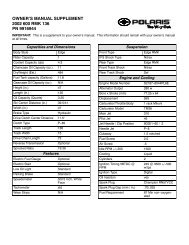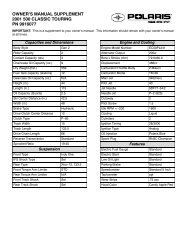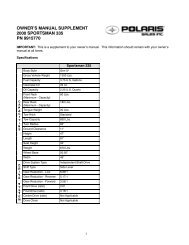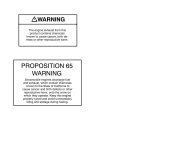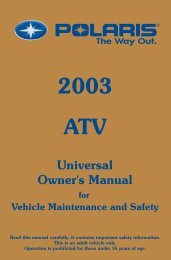Owner's Manual - Polaris
Owner's Manual - Polaris
Owner's Manual - Polaris
- No tags were found...
Create successful ePaper yourself
Turn your PDF publications into a flip-book with our unique Google optimized e-Paper software.
MAINTENANCEPVT SystemThe basic operation of the POLARIS PVT system is dependent onengine speed and vehicle torque requirements. As engine speedincreases, the force exerted on the movable drive sheave by the flyweightsalso increases. This, in turn, increases the amount of pinchapplied to the drive belt. Similarly, if the engine speed decreases, theamount of centrifugal force decreases, reducing the amount of beltpinch.On POLARIS ATVs, the approximate gear ratio difference betweenhigh and low range is 1:2.25. This difference in gearing affects the operationof the PVT, especially at speeds less than 7 MPH (11 km/h), due tothe system's dependence on engine speed.For example, when operating at a ground speed of 3 MPH (5 km/h) inlow range, the engine speed would be around 3000 RPM. This is wellabove the engagement speed of 1600 - 1800 RPM. However, in highrange at 3 MPH (5 km/h), the engine would be running at only 1500RPM. Whenever operating this close to the engagement speed, theengine may be running at a speed too low to provide the pinch needed toprevent belt slip. Belt slip is responsible for creating the excessive heatthat destroys belts, wears clutch components and causes outer clutchcovers to fail.The air temperature in the clutch cover is substantially reduced by usinglow range while operating at low ground speeds. Reducing the temperatureinside the clutch cover greatly extends the life of the PVT components(belt, cover, etc.).107



